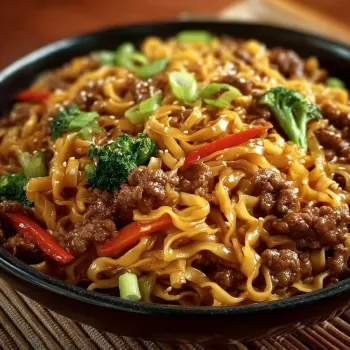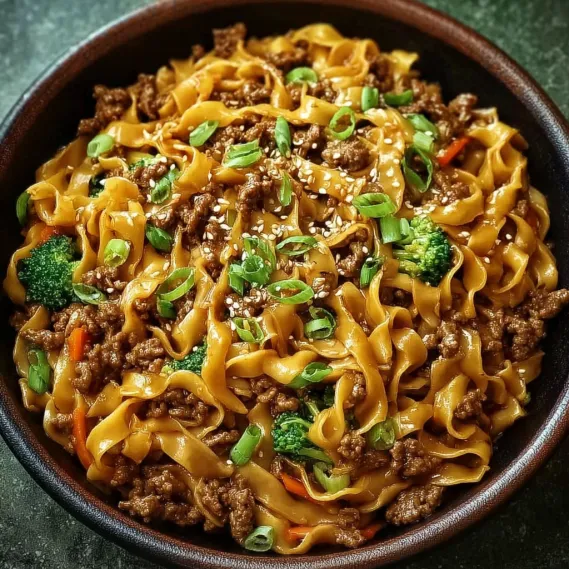 Pin
Pin
This hearty Mongolian Ground Beef Noodles dish transforms everyday ingredients into a restaurant-worthy meal in just 25 minutes. The rich, savory-sweet sauce clings to every strand of noodle, making this an irresistible weeknight dinner option when takeout cravings hit but you need something quicker and more budget-friendly.
I first created this recipe during a particularly hectic week when I needed dinner on the table fast but couldn't bear the thought of another basic pasta night. My family now requests these noodles almost weekly, and I've found it's the perfect recipe to teach teenagers who are just learning to cook.
Ingredients
- Ground beef: provides the hearty protein base and absorbs all the delicious sauce flavors
- Noodles: offer flexibility use spaghetti from the pantry or authentic lo mein when available
- Fresh garlic and ginger: create the aromatic foundation essential for authentic Asian flavor
- Low-sodium soy sauce: delivers umami depth without overwhelming saltiness
- Brown sugar: balances the savory elements with necessary sweetness
- Beef broth: enhances the meaty flavor and creates sauce volume
- Cornstarch: transforms the sauce from watery to gloriously clingy optional but recommended
- Red pepper flakes: add customizable heat adjust according to your spice preference
- Green onions: provide fresh contrast and visual appeal to the finished dish
Step-by-Step Instructions
- Cook the Noodles:
- Bring a large pot of water to a rolling boil and add a generous pinch of salt. Add your noodles of choice and cook exactly according to package directions until al dente. Timing is important here to prevent mushy noodles that will break apart when tossed with the sauce. Reserve about 1/4 cup of the cooking water before draining, as this starchy liquid can help the sauce adhere better to the noodles if needed.
- Brown the Beef:
- Heat a large skillet or wok over medium-high heat until you can feel warmth when holding your hand 6 inches above the surface. Add vegetable oil and swirl to coat the cooking surface. Add ground beef, breaking it apart with a wooden spoon into small, even crumbles. Cook undisturbed for about 2 minutes to develop browning, then stir and continue cooking until no pink remains, about 5 minutes total. If your beef releases excessive fat, tilt the pan and spoon off all but 1 tablespoon.
- Add Aromatics:
- Reduce heat to medium and add minced garlic and grated ginger directly to the cooked beef. Stir continuously for 1-2 minutes, being careful not to let the garlic brown or burn. You should immediately smell the fragrant aromatics releasing their essential oils. This brief cooking period mellows their raw flavor while infusing the oil and beef with their essence.
- Make the Sauce:
- In a separate bowl, whisk together soy sauce, packed brown sugar, beef broth, and red pepper flakes if using. Make sure the brown sugar fully dissolves for a smooth sauce. For a thicker consistency, create a slurry by mixing cornstarch with 2 tablespoons of cold water until completely smooth, then stir this into your sauce mixture. Having the sauce pre-mixed ensures even flavor distribution and prevents the cornstarch from clumping.
- Combine Everything:
- Pour the prepared sauce directly into the skillet with the beef mixture. Bring to a gentle simmer and cook for 3-5 minutes, stirring occasionally. Watch as the sauce darkens slightly and begins to reduce. When it coats the back of a spoon, add the drained noodles to the skillet. Using tongs, gently toss and fold the noodles into the sauce until every strand is glossy and coated. If the mixture seems dry, add a splash of the reserved pasta water.
- Garnish and Serve:
- Transfer the finished noodles to serving bowls or a large platter. Sprinkle generously with chopped green onions, focusing on the bright green parts for color contrast. Add a light dusting of sesame seeds if desired for texture and visual appeal. Serve immediately while piping hot, as the dish is at its most flavorful temperature when freshly made.

The brown sugar might seem like a lot at first glance, but trust me on this one. After years of tweaking this recipe, I discovered this exact amount creates that authentic Mongolian sauce flavor without becoming too sweet. My daughter actually first pointed this out when I tried reducing the sugar once, and she immediately noticed the flavor wasn't quite right. Some cooking lessons come from unexpected teachers!
Customize Your Noodles
While this recipe calls for basic noodle options, the sauce works beautifully with many varieties. Rice noodles create a lighter dish with a pleasant chew, while udon noodles offer a satisfying thickness that stands up wonderfully to the robust sauce. For a lower-carb option, try shirataki noodles or even spiralized zucchini. The sauce is so flavorful that it elevates whatever base you choose to use.
Make It A Complete Meal
Transform this simple noodle dish into a complete dinner by adding vegetables. Broccoli florets, sliced bell peppers, or snow peas can be added during the last few minutes of cooking the beef for a one-pan meal. For a beautiful presentation, serve the noodles topped with a soft-boiled egg, which adds richness as the yolk combines with the sauce. A side of simple cucumber salad dressed with rice vinegar provides a refreshing contrast to the umami-rich noodles.
Storage And Reheating
These noodles store beautifully in the refrigerator for up to 3 days in an airtight container. The flavors actually develop and deepen overnight, making this an excellent make-ahead meal. When reheating, add a tablespoon of water before microwaving to revitalize the sauce. For best texture, reheat in a skillet over medium heat, adding a small splash of beef broth to loosen the sauce as it warms through.
Common Questions About This Recipe
- → What type of noodles work best?
Lo mein, ramen, or spaghetti all complement the savory Mongolian sauce and ground beef texture well. Choose based on preference or what's on hand.
- → Can I make this dish spicier?
Yes, adding crushed red pepper flakes to the sauce or topping the finished dish with extra chili oil will boost the heat.
- → Are there ways to add vegetables?
You can toss in bell peppers, snap peas, carrots, or broccoli florets along with the beef, sautéing until crisp-tender before adding the sauce.
- → How do I achieve a thicker sauce?
Mix cornstarch with a bit of water and stir it into the sauce while simmering. This helps create a glossy, clingy coating for the noodles.
- → Is there a substitute for ground beef?
Ground turkey, ground chicken, or even crumbled tofu work well and readily absorb the Mongolian sauce blend.
